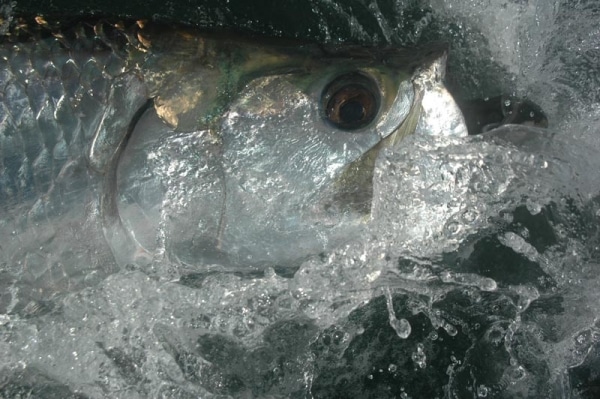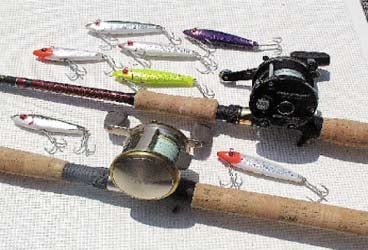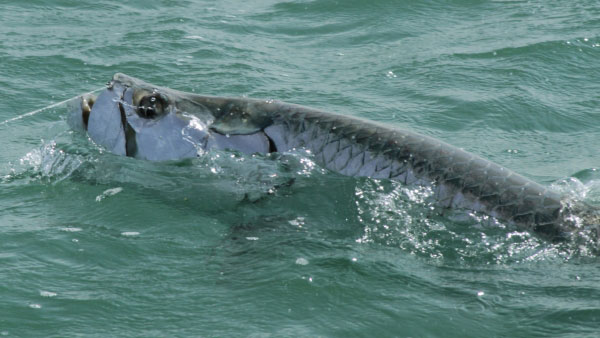As we idled out into Tampa Bay on a sticky August morning, I didn’t quite know what to expect. My tarpon experience had been limited to live-bait fishing because, like any other species, these fish jump at a live meal. But this was to be a plugging trip. I thought we’d be lucky to fool even one fish.
I would be fishing with the guidance of two guys who had tarpon-plug fishing in their blood: Eric Bachnik and Frank Smith. Bachnik, sales manager for MirrOlure, is the grandson of Harold LeMaster, founder of L&S Bait Co. Smith’s father, Kirk, was LeMaster’s partner and has tossed plugs for tarpon in Tampa Bay for over 35 years.
Sight-casting plugs shares much of the skills and excitement that are part of fly fishing. Besides demanding skill and accuracy in casting, plugging requires a realistic retrieve and lots of practice to reach a successful cast-to-hookup ratio. A great bass fisherman is usually a refined plug-caster, so are many hardcore tarpon anglers.
Before fly-gear manufacturers developed the heavy tackle necessary to subdue large saltwater fish, plugs were the mainstays in artificials. Harold LeMaster brought his love of freshwater plugging, plus his passion for making lures, to Tampa Bay, Florida, in the early 1950s. Tarpon soon became LeMaster’s favorite quarry, so he had to develop a way to catch them on plug.
“He’d go out every day and fish for tarpon,” says Bachnik. “Fifty years ago there were two ways to fish for tarpon: soaking pinfish on the bottom or plugging as they moved down the coast. Harold liked to throw larger lures, which sometimes led to strikes from larger fish.”
On June 6, 1952, LeMaster hooked one of those “larger” fish on one of his plugs. After 17-1/2 hours, unable to turn the monster with 220 yards of 18-pound, hollow-braided nylon, he could only hang on as the fish dragged him for more than 25 miles. The fight lingered into the night, and a crowd of more than 1,000 people lined a nearby causeway to watch, guided by huge spotlights from the fire department, as he battled both the tarpon (estimated at 170 pounds) and fatigue. Finally, the MirrOlure sprang out of the tarpon’s mouth, landing on LeMaster’s shirt, its hooks badly corroded from the saltwater and acid in the fish’s mouth.
LeMaster relished what the rest of us anticipate when reeling in a plug: the strike. Bachnik agrees that’s the most exciting moment. “We’re using methods and plugs that you’d normally use to catch bass or trout, but instead of fishing for 5- to 10-pounders, we’re targeting a species that gets well over 100 pounds,” he says.
Give ’em a Gearful
Although the fishing style may remind some of freshwater or mangrove fishing, casting to large tarpon requires tackle that is both resilient and responsive. Top guides like Tampa Bay’s Capt. Bob Puccinelli consider the right gear to be a critical element in plugging for tarpon. A three-time winner of the King Tarpon Classic, one of the area’s most prestigious tarpon tournaments with an artificials-only format, Puccinelli’s gear holds up to the biggest tarpon. Rods with muscle, reels with smooth drags and Dacron line prove most reliable and consistent.
Spare the rod, spool the ‘poon. That would be an appropriate mantra when plugging for big tarpon. The need to “flip” a plug at an approaching school, drive home a solid hook-set, and rely on endurance under sustained/ erratic pressure all weigh heavily on your rod. Focus on length and stiffness when searching for a tarpon-plugging rod. Puccinelli prefers a 7- to 7-1/2-foot, medium-action, graphite custom rod with a bouncy tip. The longer rod helps the hook-set, while the bouncy tip allows the rod to fling your plug farther when casting. Experienced plug-casters won’t have a problem with this rig, but for those new to baitcasting gear or tarpon fishing, manufacturers reveal what to look for in rods.
Kenny Carman of Biscayne Rods in Miami, Florida, says anglers should avoid going too light when choosing a rod. “It’s all a simple math calculation,” says Carman. “You want a situation where the rod’s going to break the line before the line breaks the rod. Rods break because people don’t consider this or want a do-it-all rig.”
Secondly, Carman would ask the angler if he prefers more line pickup and longer casts or more pressure on the fish instead of the angler. A longer rod (7-1/2 feet) will cast farther but put more pressure on the angler. A shorter rod transfers pressure to the fish but won’t pick up as much line. Ideally, anglers should use a 7-footer, but for starters, try a rod under 7 feet to gain more control and accuracy. All rods should be in the 12- to 20-pound range.
When shopping for the right tip, look for one with a slight flex. All Star Rods in Houston, Texas, has a “Power Rating” system that numbers its rods from one to eight (with eight the stiffest). Marketing director Brett Crawford suggests ‘pooning with a rod rated 5 or 6. This way, the rod will be stiff, but the tip will have enough flex to flip a plug.
Once you choose the rod, you need a reel and line to match. Puccinelli likes to spool his baitcasters with 175 to 200 yards of 16-to 20-pound Gudebrod Dacron line. Dacron, with less stretch and smaller diameter than mono, provides a more effective hook-set and more line capacity on the already-small spools. He prefers the Abu-Garcia Ambassadeur 6500 series or the Daiwa Millionaire CV-Z253A. Other manufacturers, including Shimano and Penn, make baitcasters with similar specifications. Whichever reel you decide on, the key is to keep the drag smooth. Carry extra drag washers, and be prepared to change them as often as necessary. This could be once a trip or once a season, depending on the reel and how many fish it catches. Once the drag starts slipping or becoming uneven, replace the washers immediately.
On the terminal end, Puccinelli uses blood knots to attach 10 feet of 30-pound mono leader, then adds 16 inches of 60-pound fluorocarbon for abrasion-resistance against the tarpon’s bony mouth. Fluorocarbon’s low visibility also helps in clear-water conditions. Use a Homer Rhode or MirrOlure loop knot to tie off the plug.
Which plugs are most effective? Because of their anatomy, tarpon prefer to feed on bait at or above eye level. Slow-sinking plugs work best for most applications. “If you look at the nature of a tarpon (massive underbite and high eye-set), they feed looking up,” says Puccinelli. “You want lures at their eye level or higher. Find something that hovers in the water or sinks slowly.”
Plugs such as MirrOlure’s TT-series work perfectly for this application. But standard hooks run small for tarpon (the series is made for trout); replace them with the No.1 VMC single hook. These hooks can be purchased directly from MirrOlure or from dealers as “tarpon specials.”
Optimum colors vary according to conditions. In areas with clear water — like the beaches and shallow flats in Tampa Bay — throw purple during low-light hours (early morning or late afternoon). Once the sun gets high, switch to chartreuse or green back/silver sides. In contrast, when the Bay’s water gets stained, Puccinelli uses white or fire-glow/silver body.
The Game’s Afoot
“You’re going to see fish pushing headwakes, rolling, laid-up, daisy-chaining swimming in single-file schools) and milling around,” Puccinelli says, describing the different things to look for when stalking schools of tarpon. Knowing specifically what to look for can be gained only through experience.
On the flats, start looking in 3 to 6 feet of water. Tarpon behavior becomes easier to recognize as you go. Look for black shadows in the water. The best scenario involves getting ahead of the school and letting the fish come to you. Cast 5 to 10 feet in front of them, and then bring the bait toward the boat. Move the bait 6 to 9 inches at a time, then twitch and repeat. Don’t slow the retrieve if the tarpon shows interest. Instead, speed up a little to imitate a fleeing baitfish.
Along the beaches, look from the surf line to the outside sandbar where water depth averages about 4 to 8 feet. Most of the time fish work the second sandbar, where wave action digs a trough. Tarpon form distinct lines as they drop into little holes along the way, looking for bait. The ideal scenario occurs when the water depth changes. They’ll slow down to get their sense of direction, setting up the perfect time to fool them with an artificial.
In dirty water like river mouths or in passes on outgoing tides, these fish don’t always group up, so Capt. Mark Bennett of Charlotte Harbor, Florida, suggests casting to an area where fish show, and then working the plug through the water column.
The low stretch of Dacron line transmits a tarpon’s power when it smashes a lure. Adding the fact that you may catch 100+-pound fish on normally outclassed casting gear really adds to the thrill of sight fishing with artificials.
However, plugging for fish as large as tarpon brings inherent dangers. When a tarpon with six or nine hooks dangling in its mouth gets close to the boat, one should be cautious. A lifetime of plug fishing for tarpon has taught Bennett some scary lessons on handling tarpon. The first advice he gives is to use a lip gaff, not a gaff with a long handle.
“We pulled a small tarpon into the boat to take a picture, and within seconds the fish went crazy,” says Bennett. “My friend thought he had it, but his hands slipped on the gaff’s handle and its hook ripped into his forearm. He needed 22 stitches.”
Bennett advises anglers to not bring fish inside the boat: It’s bad for the fish and invites disaster. He suggests that before people use a lip gaff, they observe a guide or someone with experience performing an on the water demonstration with a tarpon before attempting the procedure. Once the tarpon is boatside, put on a set of thick gloves and run the lip gaff through the bottom lip. Avoid putting your hands into the tarpon’s mouth or anywhere near the plug. The hooks can snag gloves. Once the gaff is set, put it tight against the boat’s rub rail to get leverage. Then use a lure retriever to remove the plug from the tarpon’s mouth. Revive the fish if necessary, and then pull the gaff out for a quick release.













